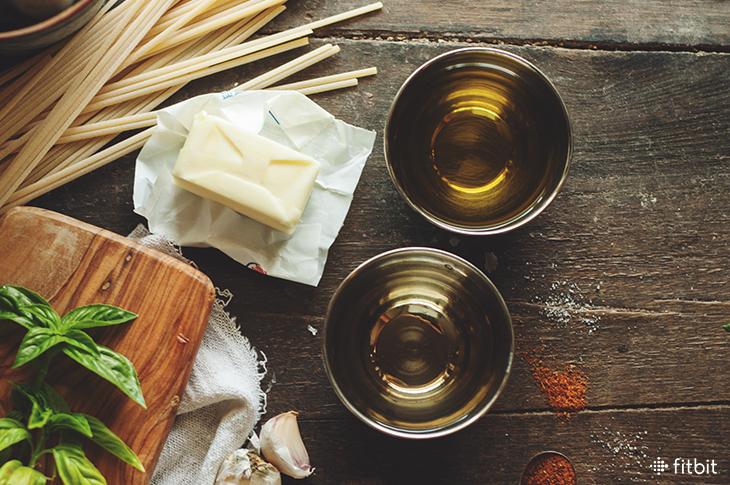
America has come a long way since the fat-phobic 80s and 90s. We now know that healthy fats are an essential part of a healthy diet—and can even contribute to weight loss! While fats are high in calories, they help you absorb certain vitamins and antioxidants and feel more satisfied.
You only need about 5 teaspoons per day, so we’re not talking copious amounts here! But the type of fat you choose is important. Years of science show unsaturated fat is the healthiest type. Saturated fat is controversial: it may not be as harmful as once thought, but no science exists to show it’s healthy, either. All fats and oils contain a mixture of saturated, monounsaturated, and polyunsaturated fats in different amounts.
With so many different cooking oils and fats lining supermarket shelves, each touting different benefits, it’s hard to know which to choose. Here are our top five choices: extra-virgin olive oil, avocado oil, nut and seed oils, grass-fed butter, and coconut oil.
The Top Five Healthy Fats
1. Extra-Virgin Olive Oil
EVOO is high in monounsaturated fats, vitamins E and K, and powerful antioxidants. Even when heated, it retains its amazing benefits and doesn’t oxidize the way polyunsaturated oils do. Following a diet rich in EVOO, like a Mediterranean-style diet, can help you live longer, keep your wits about you, protect your heart, and possibly reduce your risk of cancer.
What to buy: Extra-virgin is worth the extra cost, as it’s produced without high heat or chemicals, retaining the most nutrients and flavor.
How to use it: Olive oil has a pleasant buttery, savory flavor. It’s a great pantry essential and everyday oil, equally delicious used raw in salad dressings or for medium-high heat cooking, like sautéing, panfrying, and roasting
2. Avocado Oil
Avocados contain heart-healthy monounsaturated fats, delivering vitamin E and an awesome cancer-fighting antioxidant called beta-sitosterol. It’s also been shown that avocado oil can help you absorb the carotenoids in orange, yellow, and red fruits and veggies by up to 15 times!
What to buy: Avocado oil is on the more expensive side, but it’s worth the investment—remember you only need a drizzle! Check the label for “cold-pressed,” but don’t worry about organic, if you’re on a budget. Avocados top the Clean Fifteen list of foods lowest in pesticides.
How to use it: Avocado oil has a smooth, buttery taste, much like the fresh fruit. You can use it everyday, just like EVOO. It also has one of the highest smoke points for cooking oils, making it a great choice for high-heat cooking, like searing and deep-frying.
3. Nut and Seed Oils
Nuts and seeds are a mix of mainly monounsaturated and polyunsaturated fats, with only a small amount of saturated fats. They each have their own benefits: Sesame seed oil contains sesamol, a powerful antioxidant known for its cancer-fighting properties, while flaxseed oil is a great source of plant omega-3s (7 g per tablespoon!), which is especially important for people who don’t eat oily fish.
What to buy: You don’t need enormous bottles of these, but cold-pressed, minimally processed varieties are the way to go. Some are best stored in the fridge (like chia, flaxseed, and sesame), because they go rancid quickly.
How to use it: Mix the flavors up a bit. Peanut and sesame oils are top choices for flavor and cooking in Asian dishes, imparting nutty flavor. Their smoke points range from no heat, such as chia and flaxseed oil, which should be saved for smoothies or as a supplement, to high heat, like peanut oil, so be sure to check before you use them.
4. Grass-fed Butter
Yes, butter is two-thirds saturated fat and contains cholesterol, but the dietary guidelines allow a small amount of saturated fat, and the recommendations for cholesterol have loosened, too. In the context of an overall good diet, a small amount of butter (1 to 2 teaspoons) is unlikely to do any harm. It’s a real food that needs very little processing (if you’ve ever over-whipped cream, you know how easy it is to make!), and it also provides vitamins A and E.
What to buy: Grass-fed butter is the best choice—it has more unsaturated fat (including omega-3s), more beta-carotene, and less saturated fat compared to butter made from milk produced by corn-fed cows.
How to use it: Keep butter at room temperature, which will allow you to spread a thinner layer across a slice of warm toast. Occasionally, if you love the flavor, it’s okay to add a small amount to medium-heat cooking. Clarified butter or ghee has a higher smoke point, so it can be used at high heat.
5. Virgin Coconut Oil
Coconut oil is certainly not a miracle food, but it’s pretty close to how nature intended it, and there’s no doubt it tastes great. It’s high in the saturated fat lauric acid, a medium-chain triglyceride, which may not be as harmful as the saturated fat found in red meat. It also contains some vitamin E and K, and polyphenol antioxidants. Some studies show the benefits of coconut oil, including being particularly good at increasing “good” HDL cholesterol. However, because it’s high saturated fat will also increase “bad” LDL cholesterol, you still need to practice moderation.
What to buy: Virgin coconut oil, which is pressed from coconut meat or milk without the use of chemicals, retains the most antioxidants.
How to use it: Coconut oil has a clean, mild, and pleasantly tropical flavor. Use it occasionally, in stir-fries over medium heat, or in baking recipes, as a substitute for a solid fat, like butter or shortening. It can be a great dairy-free alternative to butter for vegans.
Fats that Fall Short
Canola (rapeseed), grapeseed, and rice bran oil are also good choices, but each has drawbacks. Canola oil is high in monounsaturated fats, vitamins E and K, and can provide some omega-3s, but it’s genetically modified, which might be a concern for some. Grapeseed oil is predominantly omega-6 polyunsaturated fats, and most people don’t need more of it in their diets. It also oxidizes (or goes rancid) more easily when exposed to oxygen, light, or heat. Rice bran oil contains two unusual substances—oryzanol, which has been shown to block the absorption of cholesterol, and tocotrienols, an antioxidant. However, it’s highly refined and processed (you can’t simply squeeze the oil out of rice, like you can out of olives or avocados).
The bottom line? There’s room for all kinds of healthy fats and oils in the kitchen. No one type is perfect, but EVOO comes pretty close. Stick to EVOO and avocado oil as your everyday oil choices, throw in nut and seed oils occasionally, and use butter and coconut oil sparingly for flavor.
Which healthy fats and oils do you keep in your pantry? Join the conversation.
This information is for educational purposes only and is not intended as a substitute for medical diagnosis or treatment. You should not use this information to diagnose or treat a health problem or condition. Always check with your doctor before changing your diet, altering your sleep habits, taking supplements, or starting a new fitness routine.

Ive just started with my fit bit and I have hit a lot of learning curves when you are not accustome to eating healthy try to figure out what is good carbs ,good fats ,good protiens, which fruits and veggies anyway I will keep working on it the hardest part for me is I just had back surgery so its hard to walk a lot still and do exercise. Wish me luck lol
Well I had some questions but when I went to post them it kept saying that it was a duplicate. So how is everyone tonight